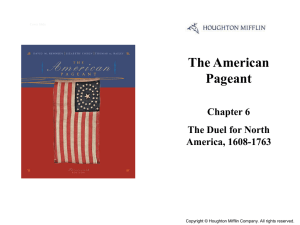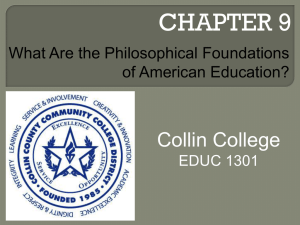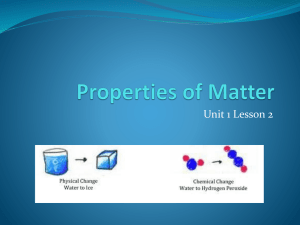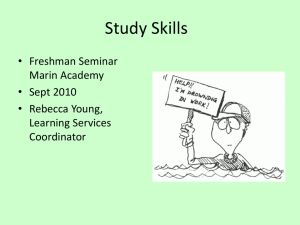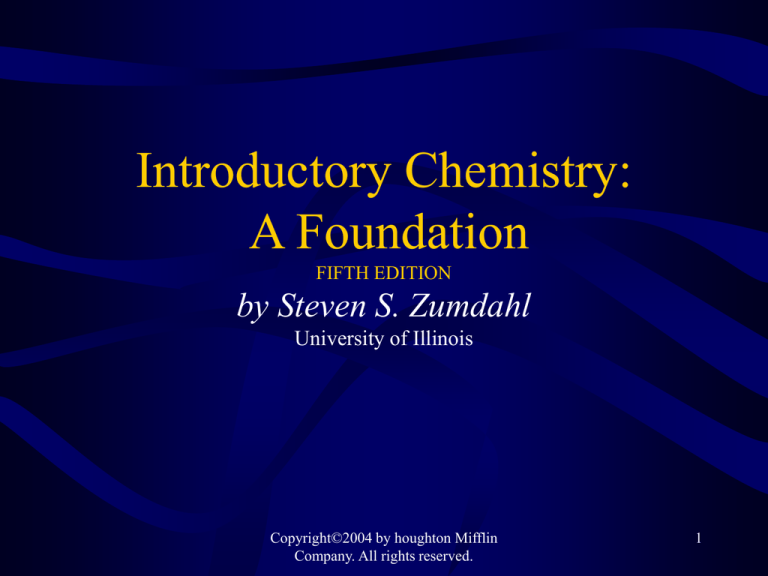
Introductory Chemistry:
A Foundation
FIFTH EDITION
by Steven S. Zumdahl
University of Illinois
Copyright©2004 by houghton Mifflin
Company. All rights reserved.
1
Reactions in Aqueous
Solutions
Chapter 7
Copyright©2004 by houghton Mifflin
Company. All rights reserved.
2
Predicting Whether a Reaction
Will Occur
“Forces” that drive a reaction:
• formation of a solid
• formation of water
• transfer of electrons
• formation of a gas
When chemicals (dissolved in water) are
mixed and one of these 4 things can occur,
the reaction will generally happen
Copyright©2004 by houghton Mifflin
Company. All rights reserved.
3
Precipitation Reactions
• in all precipitation reactions, the ions of one substance
are exchanged with the ions of another substance when
their aqueous solutions are mixed
• At least one of the products formed is insoluble in
water
KI(aq) + AgNO3(aq) KNO3(aq) + AgIs
K+
Ag+
K+
Ag
I-
NO3-
I
NO3-
Copyright©2004 by houghton Mifflin
Company. All rights reserved.
4
Dissociation
• ionic compounds
– metal + nonmetal (Type I & II)
– metal + polyatomic anion
– polyatomic cation + anion
• when ionic compounds dissolve in water the anions
and cations are separated from each other; this is called
dissociation
• we know that ionic compounds dissociate when they
dissolve in water because the solution conducts
electricity
Copyright©2004 by houghton Mifflin
Company. All rights reserved.
5
Electrical Conductivity of
Aqueous Solutions
Copyright©2004 by houghton Mifflin
Company. All rights reserved.
6
Dissociation
• potassium chloride dissociates in water into
potassium cations and chloride anions
KCl(aq) = K+ (aq) + Cl- (aq)
K
Cl
K+
Cl-
• copper(II) sulfate dissociates in water into
copper(II) cations and sulfate anions
CuSO4(aq) = Cu+2(aq) + SO42-(aq)
Cu SO4
Cu+2
Copyright©2004 by houghton Mifflin
Company. All rights reserved.
SO42-
7
Dissociation
• potassium sulfate dissociates in water into
potassium cations and sulfate anions
K2SO4(aq) = 2 K+ (aq) + SO42-(aq)
K
SO4 K
K+
SO42K+
Copyright©2004 by houghton Mifflin
Company. All rights reserved.
8
Process for Predicting the Products of
a Precipitation Reaction
Determine what ions each aqueous reactant has
Exchange Ions
– (+) ion from one reactant with (-) ion from other
Balance Charges of combined ions to get formula of
each product
Balance the Equation
– count atoms
°
Determine Solubility of Each Product in Water
– solubility rules
– if product is insoluble or slightly soluble, it will precipitate
Copyright©2004 by houghton Mifflin
Company. All rights reserved.
9
Precipitation of
silver chloride:
Silver nitrate is mixed
with Potassium
Chloride
Copyright©2004 by houghton Mifflin
Company. All rights reserved.
10
Solubility Rules
-
Most compounds that contain NO3 ions are soluble
Most compounds that contain Na+, K+, or NH4+ ions are
soluble
Most compounds that contain Cl- ions are soluble,
except AgCl, PbCl2, and Hg2Cl2
Most compounds that contain SO42- ions are soluble,
except BaSO4, PbSO4, CaSO4
° Most compounds that contain OH- ions are slightly
soluble (will precipitate), except NaOH, KOH, are
soluble and Ba(OH)2, Ca(OH)2 are moderately soluble
± Most compounds that contain S2-, CO32-, or PO43- ions
are slightly soluble (will precipitate)
EXERCISE: p.201, question 15
Copyright©2004 by houghton Mifflin
Company. All rights reserved.
11
Writing equations for the
reactions - Ionic Equations
• equations which describe the chemicals put into the water
and the product molecules are called molecular equations
KCl(aq) + AgNO3(aq) KNO3(aq) + AgCl(s)
• equations which describe the actual ions and molecules in
the solutions as well as the molecules of solid, liquid and
gas not dissolved are called ionic equations
K+ (aq) + Cl- (aq) + Ag+ (aq) + NO3- (aq) K+ (aq) + NO3- (aq) + AgCl(s)
Copyright©2004 by houghton Mifflin
Company. All rights reserved.
12
Ionic Equations
• ions that are both reactants and products are
called spectator ions
K+ (aq) + Cl- (aq) + Ag+ (aq) + NO3- (aq) K+ (aq) + NO3- (aq) +
AgCl(s)
• an ionic equation in which the spectator ions are
dropped is called a net ionic equation
Cl- (aq) + Ag+ (aq) AgCl(s)
Copyright©2004 by houghton Mifflin
Company. All rights reserved.
13
Electrolytes
• electrolytes are substances whose aqueous
solution is a conductor of electricity
• all electrolytes have ions dissolved in water
• in strong electrolytes, virtually all the
molecules are dissociated into ions
• in nonelectrolytes, none of the molecules are
dissociated into ions
• in weak electrolytes, a small percentage of the
molecules are dissociated into ions
Copyright©2004 by houghton Mifflin
Company. All rights reserved.
14
Reactions that Form Water:
Acids + Bases
Arrhenius:
• Acids all contain H+ cations and an anion
• Bases all contain OH- anions and a cation
• when acids dissociate in water they release
H+ ions and their anions
• when bases dissociate in water they release
OH- ions and their cations
Copyright©2004 by houghton Mifflin
Company. All rights reserved.
15
Acid-Base Reactions
• in the reaction of an acid with a base, the H+1 from
the acid combines with the OH-1 from the base to
make water
• the cation from the base combines with the anion
from the acid to make the salt
acid + base salt + water
H2SO4(aq) + Ca(OH)2(aq) CaSO4(aq) + 2 H2O(l)
• the net ionic equation for an Acid-Base reaction is
always
H+ (aq) + OH- (aq) H2O(l)
EXAMPLE: p. 203, problem 39
Copyright©2004 by houghton Mifflin
Company. All rights reserved.
16
Reactions of Metals with Nonmetals
(Oxidation-Reduction)
• The metal loses electrons and becomes a cation
– We call this process oxidation
• The nonmetal gains electrons and becomes an
anion
– We call this process reduction
• In the reaction, electrons are transferred from the
metal to the nonmetal
Copyright©2004 by houghton Mifflin
Company. All rights reserved.
17
Oxidation-Reduction Reactions
• All reactions that involve a transfer of one
or more electrons are called oxidationreduction reactions
• We say that the substance that loses
electrons in the reaction is oxidized and the
substance that gains electrons in the
reaction is reduced.
Copyright©2004 by houghton Mifflin
Company. All rights reserved.
18
Predicting Products of
Metal + Nonmetal Reactions
•
metal + nonmetal ionic compound
– ionic compounds always solids unless dissolved in water
•
•
•
in the ionic compound the metal is now a cation
in the ionic compound the nonmetal is now an anion
to predict direct synthesis of metal + nonmetal
determine the charges on the cation and anion
• from their position on the Periodic Table
determine numbers of cations and anions needed to have
charges cancel
balance the equation
EXAMPLE: p. 204, problem 49
Copyright©2004 by houghton Mifflin
Company. All rights reserved.
19
Another Kind of
Oxidation-Reduction Reaction
• Some reactions between two non-metals are
also oxidation-reduction reaction
• Any reaction in which O2 is a reactant or a
product will be an oxidation-reduction
reaction
CH4(g) + 2 O2(g) CO2(g) + 2 H2O(g)
2 SO3(g) 2 SO2(g) + O2(g)
Copyright©2004 by houghton Mifflin
Company. All rights reserved.
20
Ways to Classify Reactions
• Reactions that involve solid formation are
called precipitation reactions
• Reactions that involve water formation are
called acid-base reactions
• Both precipitation reactions and acid-base
reactions involve compounds exchanging
ions, ion exchange reactions are called
double displacement reactions
Copyright©2004 by houghton Mifflin
Company. All rights reserved.
21
Double Displacement Reactions
• two ionic compounds exchange ions
• X Y (aq) + AB (aq) XB + AY
• reaction will not occur unless one of the
products either (1) precipitates, (2) or is
water
Copyright©2004 by houghton Mifflin
Company. All rights reserved.
22
Ways to Classify Reactions
• Reactions that involve electron transfer are called
oxidation-reduction reactions
– Metals + Nonmetal
– O2 as a reactant or product
• Reactions that occur in aqueous solution because one
of the products is a gas are called gas forming
reactions
NaHCO3(aq) + HCl(aq) NaCl(aq) + CO2(g) + H2O(l)
Copyright©2004 by houghton Mifflin
Company. All rights reserved.
23
Ways to Classify Reactions
• Reactions that involve one ion being
transferred from one cation to another are
called single replacement reaction
X Y + A X + A Y
Zn(s) + 2 HCl(aq) ZnCl2(aq) + H2(g)
Fe2O3(s) + 2 Al(s) 2 Fe(s) + Al2O3(s)
Copyright©2004 by houghton Mifflin
Company. All rights reserved.
24
Other Ways to Classify Reactions
• Reactions in which O2(g) is reacted with a carbon
compound are called Combustion Reactions
• Combustion reactions release a lot of energy
• Combustion reactions are a subclass of OxidationReduction reactions
• Combustion of carbon compounds produces CO2(g)
• Combustion of compounds that contain hydrogen
produces H2O(g)
C3H8(g) + 5 O2(g) 3 CO2(g) + 4 H2O(g)
Copyright©2004 by houghton Mifflin
Company. All rights reserved.
25
Other Ways to Classify Reactions
• Reactions in which chemicals combine to make
one product are called Synthesis Reactions
• Metal + Nonmetal reactions can be classified as
Synthesis Reactions
2 Na(s) + Cl2(g) 2 NaCl(s)
• Reactions of Metals or Nonmetals with O2 can be
classified as Synthesis Reactions
N2(g) + O2(g) 2 NO(g)
• These two types of Synthesis Reactions are also
subclasses of Oxidation-Reduction Reactions
Copyright©2004 by houghton Mifflin
Company. All rights reserved.
26
Other Ways to Classify Reactions
• Reactions in which one reactant breaks
down into smaller molecules are called
Decomposition Reactions
• Generally initiated by addition of energy
– Addition of electric current or heat
• Opposite of a Synthesis Reaction
2 NaCl(l) electric
2 Na(l) + Cl2(g)
current
Copyright©2004 by houghton Mifflin
Company. All rights reserved.
27
Summary of Classes of
Reactions:
Copyright©2004 by houghton Mifflin
Company. All rights reserved.
28


